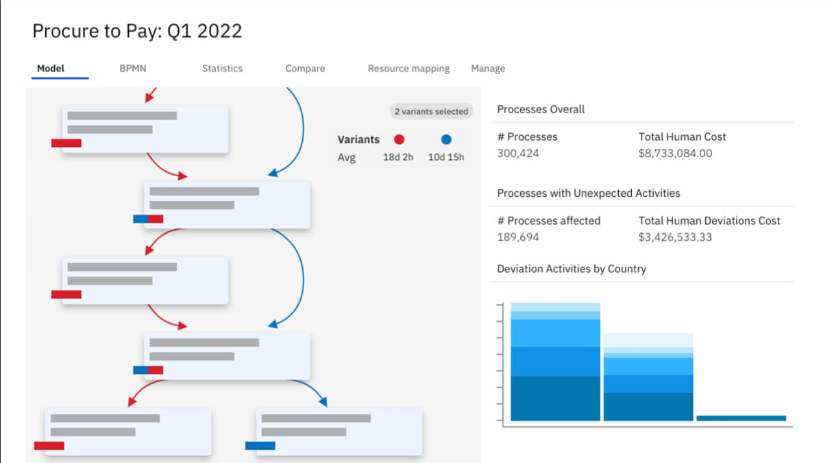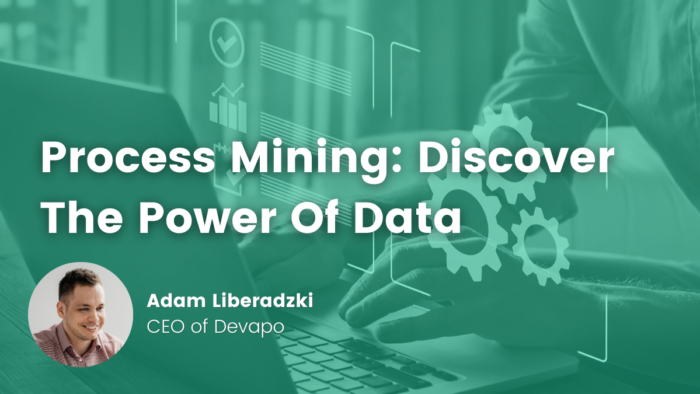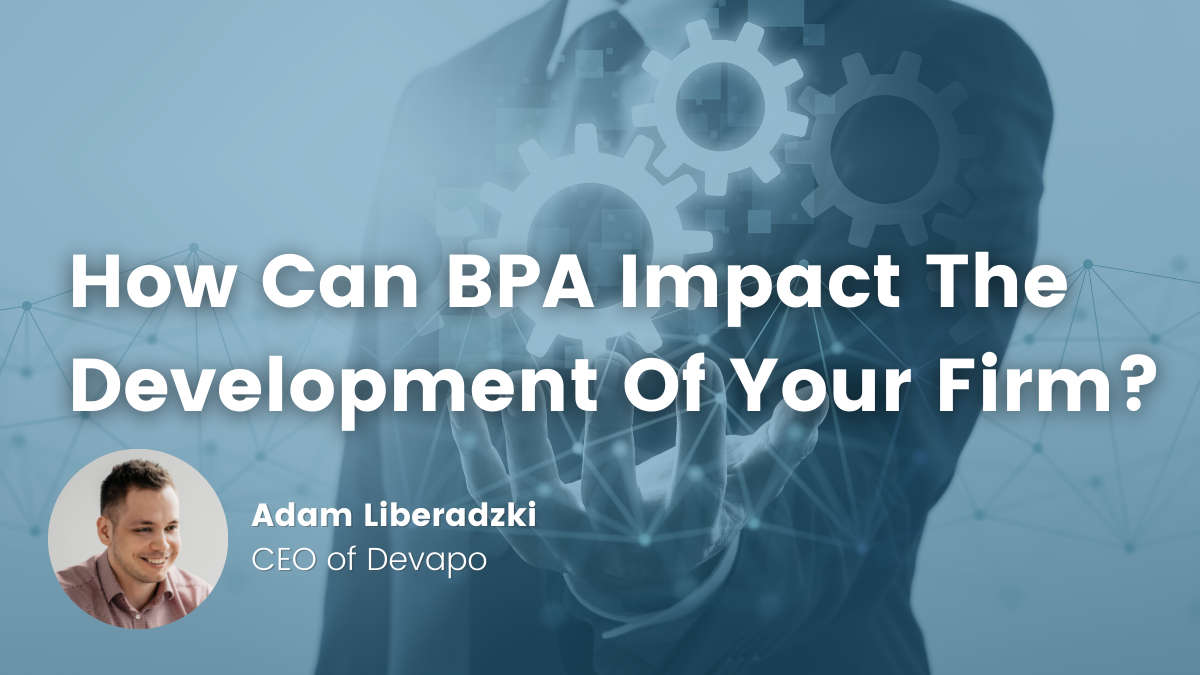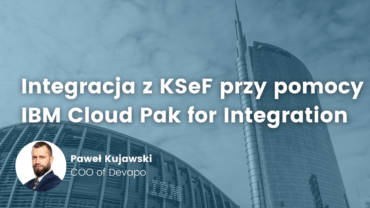- Adam Liberadzki
- Read in 7 min.
One of your goals as a CEO is to improve efficiency of your business. I bet you can agree with me, that this is not always an easy task to identify these areas even with help of managers. Imagine a solution that can tell you what parts of your processes are your bottlenecks. This is where process mining comes in. You will know exactly where the inefficiencies are. Thus you will get a huge hint on where to start the optimization.
In today’s fast-paced business environment, it is essential to have streamlined and efficient processes to remain competitive. This powerful technology allows organizations to extract valuable insights from their operational data to improve workflows. Stay with me to learn more about process mining and see it in action!
What is process mining?
Process mining lies somewhere between business process management (BPM) and Data Science. This methodology applies data extraction, processing and analysis to improve processes and consists of several stages. I want to guide you through each of these steps briefly, so you can have a better overall understanding.
Data preparation
At this point of process mining, all relevant data is collected from various sources, such as event logs, databases, and other information systems (e.g. ERP, CRM, BSS, etc.). The reason behind it is to get a base of information that can be later used to understand the processes. The data is cleaned, filtered, and transformed to eliminate any inconsistencies, redundancies, and errors that might affect the accuracy of the analysis. This stage is important to ensure that the data used for process mining is accurate and reliable.
Process discovery
In this stage, process mining techniques are used to automatically generate a process model from the collected data. This model can help to identify the different steps involved in the process and their relationships. You will be able to understand the current state of the process and identify areas for improvement.
Conformance checking
Once the process model has been generated, the next step of process mining is to check whether the actual process follows the model. This stage involves comparing the process model with the event logs to identify deviations and measure the level of conformance or to find inefficiencies in the current process.
Performance analysis
To analyze the performance of the process, including factors such as throughput, cycle time, and bottlenecks, different process mining techniques are used. This helps to discover areas where the process can be optimized to improve efficiency.
Process enhancement
Based on the insights gained from the previous stages, this final step of process mining involves implementing changes to the operational processes to improve its efficiency and effectiveness. This may involve making changes to the process model, redesigning workflows, or changing the way data is collected and analyzed. Thanks to that, the process is continuously improved to meet changing business needs.
It is worth noting that, like the life cycle of business process management, the stages of process mining also have a circular flow. So it is worth monitoring processes constantly and optimizing them as needs arise. This is a good practice. Unfortunately, is often neglected by organizations, which then results in problems when changes are on the horizon.
All this may seem complicated. Of course, if you want to go through all the steps yourself, using your own resources, it can be a Sisyphean job. However, process mining is not a new trend that appeared out of nothing. Its history can be traced back to the 1990s. Over all these decades the concept and the process mining software solutions have been developed and strengthened through many useful features, such as AI and Machine Learning. An example of such a solution that can do almost all the work for you is IBM Process Mining. But before I introduce you to this one, let’s discuss the advantages that process mining can give you.
Benefits of leveraging process mining
Process mining has several advantages over traditional process analysis techniques, such as process mapping and simulation. Firstly, it provides a more accurate and objective view of the process, as it is based on actual data rather than assumptions or estimates. Secondly, it is faster and more cost-effective. It requires less manual effort and can be automated to a large extent. It can analyze large volumes of data from various sources and provide a holistic view of the process. Here are some more pros to make it clear that the solution is worth at least some attention.
- Increased visibility into business processes. Process mining provides a detailed view of how existing processes are executed within an organization. This allows businesses to understand the flow of work, identify bottlenecks, and pinpoint inefficiencies that may be impacting productivity.
- Improved efficiency. By analyzing event data, process mining can help organizations optimize their workflows to reduce process lead time, cut costs, and increase output. Thanks to process mining you also will be able to find repetitive tasks that could be automated.
- Better decision-making. As process mining handling data in real-time, it can help identify patterns, predict future events, and make informed decisions about process improvements and resource allocation.
- Enhanced compliance and risk management. By monitoring process execution, process mining can help you identify potential risks and issues. This allows to take proactive measures and ensure compliance with regulations and standards.
- Increased customer satisfaction. Process mining can help businesses identify workflows issues that are impacting customer satisfaction. With insights you can improve customer retention.

Process Mining solutions
Process mining solutions are software tools that use algorithms to extract meaningful information from event log data and other sources. The process mining tools may be able to identify the most common paths through a process, the amount of time each step takes, the frequency of errors, and other issues.
IBM process mining software
One of the leading providers of process mining is IBM. IBM Process Mining is a cloud-based solution that enables organizations to visualize, monitor, and optimize their business processes
IBM Process Mining capabilities are enormous. You can gain transparency with data-driven, fact-based process intelligence. The tool will reveal process inefficiencies, and you can trigger actions to improve them with a few clicks. You can also manage compliance from within IBM Process Mining, thanks to its process execution monitoring feature. The result of these actions will be increased productivity and accelerated digital transformation.

The process mining solution is a part of a bigger picture, called Cloud Pak for Automation. Thanks to combining it with others products you can drive continuous process improvements by triggering corrective actions or generating RPA bots.
This process mining software provides a user-friendly interface and a wide range of process mining techniques to help organizations achieve their process improvement goals. For example, it is powered by AI process simulations by performing what-if analyses and supports integrations with hundreds of sources.
If you’re curious about the topic of process mining, or IBM solution be sure to schedule a virtual coffee with me. I will be happy to discuss the possibilities of how it can support your business.
How can Devapo help you?
We can provide valuable support to clients in implementing IBM process mining solutions. First and foremost, we can assist the client in understanding their specific business processes and identifying areas where process mining can provide insights and improvements. Once it’s done, we can help you gather and prepare the data needed for analysis using IBM process mining tools.
We will be at your disposal in the implementation process, ensuring that the software is properly configured and integrated with your existing systems. This may involve customizing the solution to meet the unique needs.
Throughout the implementation process, we provide training and support to the teams. You can be sure they are comfortable using the solution and can effectively leverage the insights provided by process mining.
Overall, with our help, you get expertise, guidance, and support throughout the process. By working closely with you, we identify key areas for improvement. Then provide the necessary tools and training to unlock the full potential of process mining to drive business success.
Process mining usage for various industries
Telecommunications
In the telecom industry, process mining can be used to optimize several processes, such as order and network management. For example, process mining can help telecom companies to analyze the customer journey from sign-up to contract renewal, identify the bottlenecks or inefficiencies in the process, and take corrective actions to enhance it. Process mining can also help telecom companies to optimize their network management processes, such as capacity planning, fault detection, and maintenance, to reduce downtime and increase network reliability.
Manufacturing
Process mining allows manufacturers to manage financial, warehouse, FTE and production processes more efficiently. By reviewing workflows and processes, inefficiencies can be mapped. Company can make decisions based on data analysis and reallocate resources such as disk space, machines or employees accordingly. These result in reduced delays or faster lead times.
Summary
In summary, process mining is a valuable technology that can help you and other organizations optimize business and operational processes, reduce costs and improve customer satisfaction. This is possible because process mining is used to analyze the current state of business process execution, identify areas for improvement, and evaluate the results of process improvements.
It is a great complement to methods such as process automation or business process management. It can first identify the best places to implement RPA bots or optimizations, and then provide a means to test their effectiveness.
Process mining systems generally present a visually appealing and data-driven view of process performance, which helps businesses see where problems and opportunities lie. It’s worth noting that IBM’s Cloud Pak for Automation is being enhanced with out-of-the-box features, in addition to its user-friendly interface.
Gain a competitive advantage and achieve business goals more effectively
with process mining









